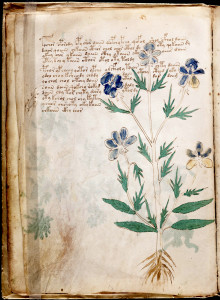There is significant controversy (and consternation) over the identities of most of the Voynich plants. The illustrator was reasonably good on details, but short on artistic skills. That’s not to say the drawings are bad—they are better than many of the herbal-style drawings of the time—but they don’t yield their secrets easily, even after centuries of study.
One plant that has escaped most of the controversy is the flower on Folio 9v. I haven’t searched the Web extensively for plant IDs for this page, but the few that I’ve seen all state that this is probably Viola tricolor. I readily agree that it looks like a viola and V. tricolor, a common wildflower, should certainly be considered, but I don’t think we can assume it’s V. tricolor without considering other possibilities.
Alternative IDs
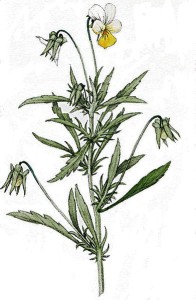 There is a field pansy called Viola arvensis that matches Plant 9v quite well. It is broadly distributed in Europe and North America and has leaves similar to Plant 9v. Many violas have rounded or heart-shaped leaves that don’t match the VM drawing at all, but V. arvensis has a mix of lanceolate and spidery palmate leaves very much like Plant 9v. V. arvensis is often white and yellow or light blue and yellow, but some variations lean toward violet-blue with yellow. Like Plant 9v, V. arvensis branches lightly and has leaves alternating up the stem at some distance—an important detail since many violas have basal whorls and tend not to branch.
There is a field pansy called Viola arvensis that matches Plant 9v quite well. It is broadly distributed in Europe and North America and has leaves similar to Plant 9v. Many violas have rounded or heart-shaped leaves that don’t match the VM drawing at all, but V. arvensis has a mix of lanceolate and spidery palmate leaves very much like Plant 9v. V. arvensis is often white and yellow or light blue and yellow, but some variations lean toward violet-blue with yellow. Like Plant 9v, V. arvensis branches lightly and has leaves alternating up the stem at some distance—an important detail since many violas have basal whorls and tend not to branch.
Despite its promising characteristics, Plant 9v probably isn’t V. arvensis. In real life it tends to be a bit squatter than this botanical drawing, which is stretched out to show details, and it is more often white than blue. But the key difference is the shape of the flowers. The shape and proportion of the petals varies from one species of viola to the next and V. arvensis flowers have a double pair at the top and a broader tongue-shaped petal at the bottom. Plant 9v, in contrast, has three at the top, rather than four.
The Corsican violet (V. corsica) and Viola dubyana both have many characteristics in common with V. arvensis and their colors range from violet-blue to a light purple. Due to the color, both these species match 9v a little more closely than V. arvensis but, once again, the shape of the flowers is wrong.
Odd Anomalies
But wait a moment.. there’s a mystery in the making. Viola tricolor doesn’t match either, even through the leaf shapes, the spacing of the leaves, the roots, and the color are a good match. As with the previous flowers, there are two pairs of petals above and a broader one below. Even an extensive search of other viola species fails to turn up an example that matches all the characteristics of the VM plant—the leaf shapes, growth habit and flower shape/colors.
Sorting out the anomaly. Could it be that the flowers on Plant 9v were drawn upside-down? If they are reversed, they would be a good match for any of the above species. This little detail, which I haven’t seen mentioned anywhere else on the Web, surprised me until I thought about it for a few moments. I’d love to believe there is some mystery message in the orientation of the flowers but…
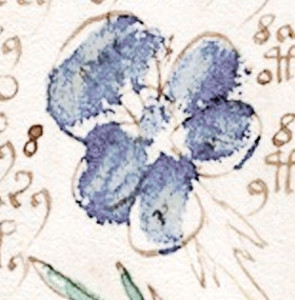 Before offering an explanation for this anatomical curiosity, it’s worth noting that there is text hidden behind the blue ink in one of the blossoms. I did some Photoshop adjustments to see if the obscured text could be seen more readily and I think I can make out the letter p on the two lower petals (at least) and what appears to be “por” on the upper one. I’ve noticed annotations on other plants, the letter “g” on a leaf that was painted green and the letters “r o t” (German for red) on the unpainted stem of plant 4r. If this says “por” then it may mean purple (or violet) as por is an abbreviation for purple in several languages.
Before offering an explanation for this anatomical curiosity, it’s worth noting that there is text hidden behind the blue ink in one of the blossoms. I did some Photoshop adjustments to see if the obscured text could be seen more readily and I think I can make out the letter p on the two lower petals (at least) and what appears to be “por” on the upper one. I’ve noticed annotations on other plants, the letter “g” on a leaf that was painted green and the letters “r o t” (German for red) on the unpainted stem of plant 4r. If this says “por” then it may mean purple (or violet) as por is an abbreviation for purple in several languages.
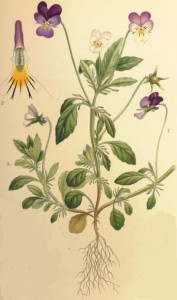 Many varieties of Viola tricolor, and the Corsican viola, are distinctly purple and the fact that the VM plant is painted blue (the trace of purple in the above example is a Photoshop artifact from trying to make the text more clear) might be due to the painter’s limited palette. Since 15th century pigments were mixed from a variety of natural materials, it took some skill to blend them. Even if the color combination was correct (e.g., red and blue to make purple), the chemical balance might not work and the result could be a muddy mess. The person blending the colors also had to have a sense of which colors to mix.
Many varieties of Viola tricolor, and the Corsican viola, are distinctly purple and the fact that the VM plant is painted blue (the trace of purple in the above example is a Photoshop artifact from trying to make the text more clear) might be due to the painter’s limited palette. Since 15th century pigments were mixed from a variety of natural materials, it took some skill to blend them. Even if the color combination was correct (e.g., red and blue to make purple), the chemical balance might not work and the result could be a muddy mess. The person blending the colors also had to have a sense of which colors to mix.
So, it’s possible that the annotation means purple, but purple pigment was not available (or too much work to create), or that por stands for something else.
A Mystery or a Practical Explanation
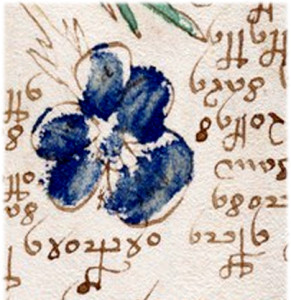 But getting back to the strange upside-down flowers… soon after I discovered the Voynich manuscript, I noticed some of the more identifiable plants may have been painted from herbarium samples. They have a flattened aspect that is not characteristic of plants drawn from life. This is particularly noticeable in the leaves. If Plant 9v had been gathered and flattened and the viola flowers flipped up to prevent the hooked part of the stem from breaking when pressed in the natural direction, that might account for the odd reversal. The person who painted them may not have cared if the upper or lower part of the flower was painted yellow or may not have noticed the petal reversal in the underlying drawing. As has been mentioned a few times, the person who painted the plants is not necessarily the same as the person who drew them.
But getting back to the strange upside-down flowers… soon after I discovered the Voynich manuscript, I noticed some of the more identifiable plants may have been painted from herbarium samples. They have a flattened aspect that is not characteristic of plants drawn from life. This is particularly noticeable in the leaves. If Plant 9v had been gathered and flattened and the viola flowers flipped up to prevent the hooked part of the stem from breaking when pressed in the natural direction, that might account for the odd reversal. The person who painted them may not have cared if the upper or lower part of the flower was painted yellow or may not have noticed the petal reversal in the underlying drawing. As has been mentioned a few times, the person who painted the plants is not necessarily the same as the person who drew them.
So, there may not be any mystery hidden in the reverse orientation, but it’s a tantalizing clue to the creation of the manuscript if the VM plants (or some of them) are drawn from gathered specimens. It means someone took the time to press them and to do so in a way that reveals the fronts of some flowers and the backs of others, a good practice when creating botanical drawings so that the shape and size of the sepals can also be seen.
Posted by J.K. Petersen

